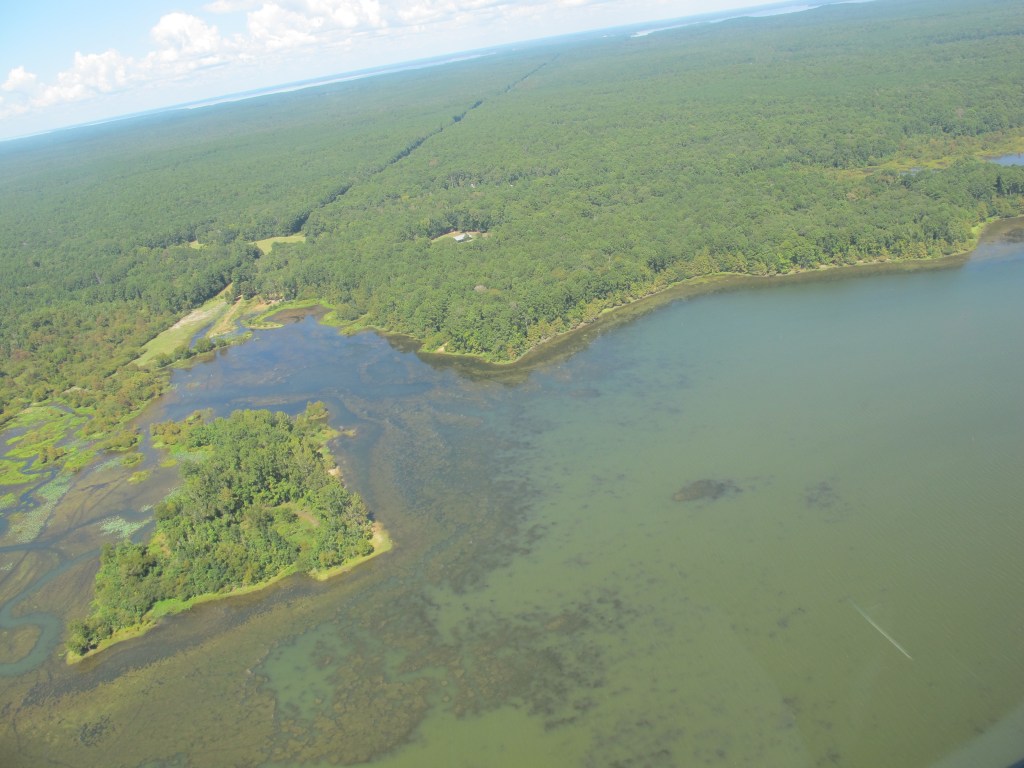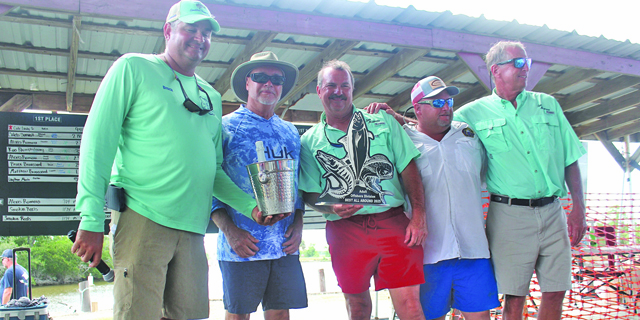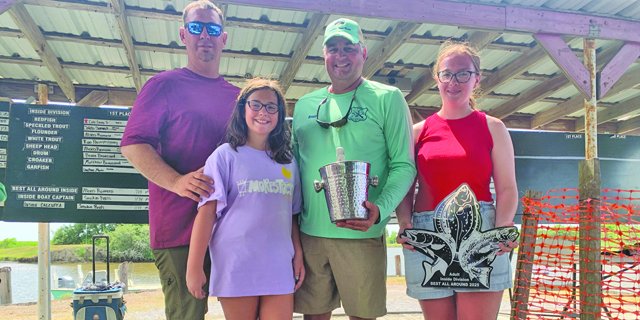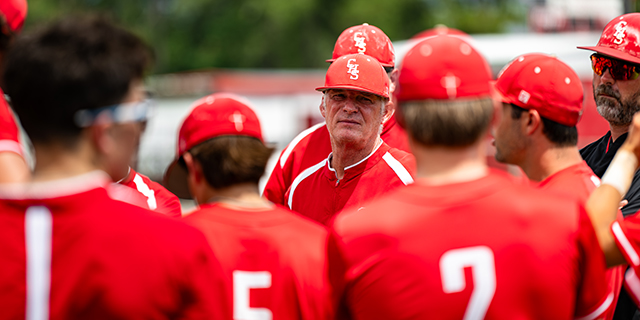Biologists, bass fishermen rejoice as hydrilla returns to Toledo Bend
Published 5:00 am Sunday, January 8, 2023

- An aerial photo from September 2022 by Todd Driscoll, Texas Parks & Wildlife Department's District 10 biologist supervisor, shows hydrilla coverage in the back third of Housen Creek at Toledo Bend. Hydrilla, a vital fish habitat, has rebounded along the Texas side of the lake bordered by Texas and Louisiana. It is growing north on the Texas side from the dam to Patroon Bayou just past Pendleton Bridge.
Grass, specifically hydrilla, isn’t always greener on the other side but there is much more of it now along the Texas side of Toledo Bend than the Louisiana side.
That is a welcome chapter to the ongoing story of critical, almost total, hydrilla loss that baffled biologists and frustrated bass anglers the past seven years. It remains an ongoing story because for some reason hydrilla has yet to rebound on the Louisiana side as it has in Texas.
Trending
The two states’ respective conservation management agencies started studies in 2021, one guided by Texas Department of Parks and Wildlife District 10 fisheries biologist Todd Driscoll and the other by Louisiana Department of Wildlife and Fisheries district manager Villis Dowden.
Texas’ deep, clear creeks apparently were the deciding factor because hydrilla has mushroomed with the help of Mother Nature. Louisiana’s clearcuts and developments apparently are contributing to more muddy water scenarios.
Much more hydrilla on Texas side
The success story is on the Texas side, where bass anglers reaped the benefits of hydrilla’s comeback as early as late September 2022.
“You know how we know it’s recovering? I haven’t been getting any complaints the last six months. … ‘Where’s the grass?’ ‘Why are you poisoning it?’ Driscoll said Jan. 4.
And it’s coming back strong on the west side, he said, after the “growing season in the spring, summer and fall” of 2022.
Trending
“It’s great news to see it grow like it is now,” he said, citing major hydrilla presence at the dam, Indian Creek, Buck Creek, Housen, Six Mile, Palo Gaucho, Clear Creek, Carrice Creek and Patroon Bayou.
Glaring exceptions on the lake’s western side are at Indian Mounds and Jesse Lowe Bay, he said.
Housen was one of the first areas with widespread return of hydrilla because it’s so fertile, Driscoll explained.
“Hydrilla is growing like gangbusters in there,” he said.
Grass mats bass anglers punched with soft plastics dwindled after a TPWD Fall 2014 aerial survey showed an estimated 14,000 acres of grass compared to virtually none in 2019. During that same period American lotus (lily pads) declined from 3,000 acres to 70 acres.
For three successive years starting in 2019, Driscoll said, “We officially had almost no hydrilla.”
Mid-‘20s flooding the main culprit
Excessive rainfall and high water-conditions in the mid-2010s was the culprit leading to the loss of vegetation, the 25-year veteran biologist has said, repeatedly. The recent hydrilla comeback on his side of the lake validates his reasoning.
Driscoll said, “During 2022 we had what I’d call normal rainfall in the reservoir. Things were kind of back to normal. Hydrilla was making a good recovery.
“Granted, we haven’t looked the last few months. I only expect the grass to come back even better (this year)” barring major flood conditions.
The 51-year-old Driscoll said he won’t be surprised to see hydrilla start up on the main lake. In fact, he expects to at least see grass appear in 3-foot depths in certain areas this year.
Talk of intentionally or unintentionally wiping out hydrilla with herbicides has more or less died. But it was a hot button topic from the late 2010s through 2021.
John Findeisen, head of TPWD’s aquatic vegetation management team, addressed the finger pointing when he told the Beaumont Enterprise in a story published Nov. 10, 2021, there was no connection between the widespread disappearance of hydrilla and herbicide applications conducted by TPWD-hired contractors in 2016-17, years that coincided with record flooding at Toledo Bend. Herbicide was applied to shallow-water areas infested with giant salvinia, Findeisen said, but it is believed overspray killed significant amounts of torpedo grass (hay grass) and other desirable aquatic plants mixed with giant salvinia.
Last week, Driscoll reiterated the fallacy that spraying wiped out hydrilla.
Addressing herbicide spraying theory
“Folks have to realize my agency (TPWD) and Villis’ agency (LDWF) had thousands and thousands of acres of hydrilla,” said the avid bass fisherman who fishes major bass tournaments on Toledo Bend and Lake Sam Rayburn.
What on earth would trigger people’s belief that biologists want to kill it? Hydrilla that first appeared in the mid-1970s is excellent habitat for bass.
Dowden, LDWF District 10 biologist supervisor Brittainey Thaxton and biologist Will Romero were quoted from their project proposal in The Daily Iberian on Jan. 9, 2022: “No large-scale chemical or biological treatments of SAV have ever occurred on Toledo Bend Reservoir due to fiscal and physical impossibilities.”
In other words, there isn’t enough manpower or money to eradicate nearly the 9,000 acres of hydrilla on the Louisiana side (9 percent coverage) seen in 2013. Ditto for Texas, which counted approximately 14,000 acres in Fall 2014.
Louisiana’s vegetation loss has been attributed to turbidity from torrential rainfalls and herbivore (animals that feed on plants). Add to the list clearcutting practices and development along Louisiana’s side, particularly the lower end of Toledo Bend.
Dowden, 50, said hydrilla’s comeback has been slow or nonexistent along Louisiana’s shoreline.
“It does look like the growth is slowly climbing a little bit. What our hopes are with some of the growth is to get ahead of the same factors that decreased coverage a couple years ago,” he said.
Louisiana tries to get ahead of curve
In other words, he said, LDWF biologists want to get ahead of the curve.
Phase 1 of Louisiana’s project began in late 2021 when five “control” structures were planted at each sample site in Cow Bayou, Blue Lake and Pirate’s Cove. Three exclosures (opposite of enclosures) were designed to maximize establishment, propagules (vegetation that can detach from a plant and give rise to a new plant) and seeding efforts. Also, one large exclosure was designed for control and another was an unfenced area of equal size to gauge herbivore impact in an open area.
The plots were monitored once a month, including replanting in some, until late 2022.
“With our plots we’re more or less seeing if we get any kind of growth at all in a controlled environment,” Dowden said.
Dowden, the son of 1980 Bassmaster Classic winner Villis “Bo” Dowden, said he and other biologists didn’t go on the lake the last few months of 2022 because of low-water conditions. Their findings before then showed some increases in vegetation.
They confirmed areas showing significant increase in vegetation were located where wind and wave action are minimal. Those areas also lacked strong currents.
“Coverage actually increased in a couple areas where we had a couple sample plots. It wasn’t necessarily because of our plantings. It was coming back naturally,” Dowden said.
A little more hydrilla in La.
“But,” he said, “we have increased coverage. We definitely have more coverage than last year, almost doubled. As far as coverage … probably 200 acres or more in the Blue Lake area, by the ramp there, compared to last year’s 20 acres. But any increase is better.”
Dowden reported in January 2022 the lake’s coverage on the Louisiana side in 2020 was 760 acres compared to 8,851 acres in 2013. The loss during that period went from 9 percent coverage to 0.8 percent coverage.
Blue Lake’s new vegetation was a mixture of American lotus and “a little bit” of American pondweed, some coontail and a little hydrilla, according to Dowden. However, it was “shallow coverage” in 5- to 7-foot depths at its deepest last fall but still more than in 2021.
The biggest surprise, he said, was vegetation showed up on the extreme upper reaches of the lake, particularly in the Circle Drive area. Bass fishing success waned there in recent years but improved catches last spring corresponded with an increased presence of hydrilla.
The Pirate’s Cove area has been a washout, literally.
“The other area that we’ve been looking at, Pirate’s Cove, we’re not seeing any kind of increased coverage at all down there,” Dowden said, adding turbidity was high and could be shading out any growth.
He noted there appears to be more clearcutting and land development in that area, which contributes to the muddy water that stifles vegetation growth.
No comeback in Pirate’s Cove
Still, Dowden was puzzled and unpleasantly surprised by the lack of grass in the Pirate’s Cove area.
His counterpart in Texas, Driscoll, agreed and said, “That’s a head scratcher. That would be the first place I’d expect hydrilla to rebound is Pirate’s Cove.”
As for the Texas side, TPWD studies focused on Housen Bay and Six Mile Creek. A series of 5×5 cages were used as test sites to determine if other animals were eating enough grass to make a difference, according to Driscoll.
“It doesn’t appear we need to go forward with any more cage activities,” he said.





